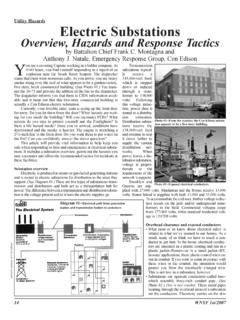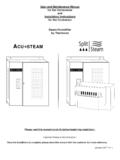Transcription of 10-40 Code 4, Steam Leak-- Do You Know the …
1 You are working in downtown Manhattan and receive analarm for a reported explosion in the street. While respond-ing, you consider the possibilities. It could be an electricalmanhole or a transformer vault. It could be the gas tank of a car ortruck. It could be the result of a natural gas leak and, reluctantly,you admit that it could be dispatcher reports that numerous calls have been receivedand, as you approach the scene, you hear a loud, roaring noise andsee a white plume of smoke pushing out from behind a you round the corner, you realize that what you are seeing ishigh-pressure Steam boiling out of a gaping hole in the ground andrising in a white, turbulent plume. The noise is deafening andthough you hear something come over the radio, you cannot makeout what was said. You are on the first-due truck at a Steam main break. A sectionof the street has been blown away by the underground break andscalding Steam is roaring out of the void.
2 What do you do? Whatare the hazards? What help do you need? Are there victims in needof assistance? Can you help them?These incidents occur infrequently and do not occur in all partsof the City. As a result, most Firefighters have never responded tosuch an incident and might not be sure of the correct answers tothese questions. This article will explain the process of generatingand delivering Steam , how it is used, where it is found, the hazardsassociated with it and how to safely respond to a Steam Con Edison Steam systemCon Edison maintains more than 100 miles of buried steampipe and supplies high-pressure Steam to nearly 2000 than half of Con Ed s Steam is produced by co-generation,an environmentally efficient process where Steam is used to turnturbines that generate electricity. It then is delivered through theunderground network to Manhattan, where it is used in buildingsfor heating and hot water.
3 Steam also is used for sterilization inhospitals and for cooking in restaurants. Additionally, Steam pipesare positioned under some sidewalks to melt snow and Edison Steam is produced by giant boilers--typicallyfueled by natural gas or oil--in generating plants found inManhattan, Brooklyn and Queens. The Steam is produced at pres-sures reaching nearly 2000 psi at 900 degrees Fahrenheit and ispiped, underground, from the generating plants to where it is usedin Manhattan from below 96th Street to the Battery. The high-pressure Steam found under the streets in Manhattan is typically at170 psi and 350 degrees Fahrenheit. While this is lower than gen-eration pressure and temperature, it still can be extremely danger-ous if there is a major rupture. Steam pipes run under both thestreets and sidewalks and manholes give utility workers access tothe underground Steam pipes ruptureSeeing Steam vapor rising in the street is not unusual in down-town Manhattan.
4 Often, it is not a Steam leak, but instead is theresult of water from water lines, sewer drains and other sourcescontacting the hot Steam pipes and boiling off. Occasionally, how-ever, Steam pipes do fail. For example, when an unusually largeamount of cold water--say from a broken water main--contacts ahot, high-pressure Steam pipe, physical stresses can be created thatthe pipe cannot handle and, as a result, it may burst. This failurereleases the high-pressure Steam , if the Steam in a section of pipe cools, watercondensate may form inside the pipe. Most of this water is prop-erly removed and does not result in any problems. Sometimes,however, it will be pushed along the pipe at high speed by thesteam until it encounters a bend in the pipe. The water slug willslam into the bend with great force and can cause the pipe to Edison Steam workers refer to Steam pipe failures ashigh-energy line breaks (HELB).
5 They can occur inside a powerplant, out in the street or in a building supplied with Steam . If notresponded to correctly, a HELB can have deadly in a power plantThere are many levels of grated ramps and platforms in a gen-erating plant. Escaping Steam quickly rises through the gratings tothe upper levels of the power plant, filling it with Steam , obscur-ing vision and making movement around the plant hazardous. Ahigh-pressure Steam leak is invisible near the source of the it cools, the Steam starts to condense and it is this condensatethat Firefighters see and identify as Steam . At the pressures andtemperatures developed in a generating plant, a pinhole leak in ahigh-pressure Steam pipe--though invisible near the source--iscapable of cutting through a steel bolt like a hot knife through but-ter. (See photo #4.) On November 10, 1992, Captain MartinMcTigue was badly burned and several other members of Rescue4 were burned to a lesser degree by a Steam leak at a Con Edisonsteam Hazards10-40 code 4, Steam Leak-- Do You know the Hazards?
6 By Battalion Chief Frank C. MontagnaPhoto #1--High-energy line break ( Steam leak).Photo #2-- Steam manholes often are found in pairs, inserted into a concretevault photos by Battalion Chief Frank C. MontagnaWNYF 1st/20085 Other potentially deadly hazards found inside a power plantinclude high voltage (up to 345,000 volts), high-pressure naturalgas lines, fuel oil and chemicals (acids and caustics).Additionally, flammable gases under pressure and compressed gascylinders--including oxygen, acetylene and hydrogen--can befound at these locations. You also will encounter sumps filled withnear-boiling water, heavy machinery and moving in the streetThe pressure released in a HELB is high enough to cause anintact street to collapse or explode out as the high-pressure steamescapes from the ruptured pipe. The escaping high-pressure steamcan hurl debris at 200 miles per hour, turning concrete, bricks,rock and manhole covers into deadly projectiles.
7 It also canexpose and damage underground high-voltage electric cables andgas Steam can obscure the vision of Firefightersand civilians, making driving hazardous for both. A collapsedstreet or a missing manhole cover may not be visible if it is with-in the Steam plume and poses a danger to anyone walking in thearea. Additionally, getting too close to the escaping Steam canresult in severe deafening sound of escaping Steam often renders radioand verbal communication ineffective in the vicinity of the many underground Steam pipes are wrapped in insulationthat contains asbestos, a burst pipe can result in an asbestos releaseover a large area. Asbestos can be contained in the vapor plumeand is a health hazard to anyone who breathes it. It will contami-nate bunker gear, equipment and vehicles, as well as buildings andany exposed civilians or leak inside buildingSteam incidents inside a building supplied by Con Edisonsteam range from minor to major.
8 A minor incident, such as a leak-ing radiator, can be treated as any other Steam emergency. A bursthigh-pressure pipe can be an entirely different matter. Inside sup-plied buildings, Steam temperatures can be as high 350 degrees withpressures reaching 170 psi. A damaged Steam riser quickly can fill aroom with super-heated Steam and in an enclosed area, oxygen maybe displaced by the Steam , creating an asphyxiation of the building in the vicinity of a burst high-pres-sure Steam pipe in an enclosed space might not have the opportu-nity to escape and rapidly could become fatalities. Additionally, thefirst-responding units may not be able to make entry into the affect-ed room or area until the Steam is shut off and the area tactical considerations, HELB tacticsGenerating plant Leak-- Never enter a Con Edison plant without anescort. Instead, respond to the designated muster site outside theplant, per AUC 338, Addendum 1.
9 Look for and contact the Con Edison White Hat. He will provideinformation on the emergency, give you an escort if entry is nec-essary and alert you to the problems and hazards inside the plant,as well as explain Con Ed s efforts to mitigate the emergency. Request an accountability report from the White Hat regardinghis personnel. He will know who was in the plant when the inci-dent occurred and if they have been accounted for. The White Hat will remain in the lobby and assign an escort toaccompany you into the plant. Move cautiously inside the plantand do not wander from your Con Edison escort. The noise ofthe escaping Steam and the normal turmoil created by a HELB inthe plant can result in disorientation to those not familiar with it,so stay close to your guide and confer with him regarding thehazards with which you are faced. Con Edison personnel will make needed repairs to mitigate theproblem.
10 Firefighters should limit themselves to search and leak in the street--Never rush into a HELB Steam is a haz-mat incident and the hazards can change frommoment to moment. So, how do you respond to these incidents? Approach outdoor incidents from upwind and stay clear of thevapor plume. Stage units and personnel in an area where theywill not become contaminated by asbestos and where communi-cation is possible. Position apparatus and set staging area upwind, outside of thevapor plume and far enough away to allow voice and radio com-munications. Look for and work with the Con Edison White Hat. This personis the Con Edison incident commander and will be your sourceof information at these incidents. Closely supervise personnel to avoid injury and asbestos con-tamination. The high temperature of the vapor plume is debilitat-ing and can be deadly.

